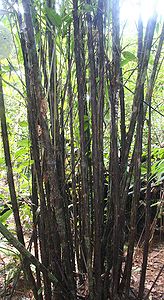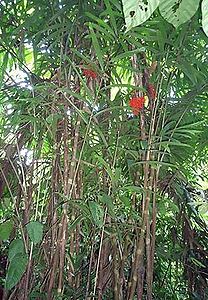Bactris coloradonis
| Bactris (BAHK-triss) coloradonis (color-ah-DOHN-iss) | |||||||
|---|---|---|---|---|---|---|---|
 Habitat | |||||||
| Scientific Classification | |||||||
| |||||||
| Synonyms | |||||||
|
| |||||||
| Native Continent | |||||||
|
| |||||||
| Morphology | |||||||
| |||||||
| Culture | |||||||
|
| |||||||
| Survivability index | |||||||
|
| |||||||
| Common names | |||||||
|
| |||||||
Contents
Habitat and Distribution
Bactris coloradonis is found in Panama: Canal Zone: woods on Barro Colorado Island.Description
Understory to medium size, clustering, very straight stems, pinnate leaves with leaflets in multiple planes, spines on stems usually in rings, branched stems, fruit orange-red. The stems of Bactris coloradonis are very straight and covered by rings of spines. A medium-sized, clustering or sometimes solitary palm with plumose leaves that have beautifully grouped leaflets which resemble little fans. It is native to rainforests below 900 m from southeastern Nicaragua through Costa Rica and Panama to western Colombia and Ecuador. A pretty palm for the understorey of the tropical or perhaps warm temperate garden. Editing by edric.
| Detailed Scientific Description |
|---|
|
Small, monoecious palm, 5-8 m. tall, often growing as single plants; trunk less than 5 cm. in diam; internodes obscurely spiny, the spines 1-6 cm. long, dull, black, broadened at base. Leaves 2.5-3 m. long; petioles usually about 1 m. long, round, canaliculate above, slightly rufous beneath, spiny only at base or rarely throughout its length (especially trueof juvenile plants), the spines 1-8.5 cm. long; rachis usually unarmed, green above, rufous below; leaflets 25 or more pairs, to 70 cm. long, 2-4 cm. wide, glabrous, gray-green, dull, the midribvery prominent above, scarcely more prominent than strong lateral veins below, the cross-veins very prominent on both surfaces, the upper surface with occasional setae, the lower surface sometimes with rufescent bands, the margins usually sparsely but prominently setose, especially near apex, the setae 5-10 mm. long or more; apex of leaflets oblique, 3-4 cm. long in the middle and distal parts of leaf, to 12 cm. long on proximal leaflets; distal leaflets regularly arranged, becoming clustered in groups of 3 or 4, the groups 2-6 cmapart, but with gaps to 30 cm. on either side, the proximal leafletsof each group inserted at a higher angle and held above the planeof the leaf, the lower most pair of leaflets at base of blade sometimes inverted with the bottom side up, the apex of leaflet pointing toward apex of blade; juvenile leaves at first entire, becoming pinnate, the outer most pair broad, the leaflets characterized by having extremely long spines on margin and on upper surface. Spathe 25 cm. long, densely brown-spiny, usually falling before fruit matures; peduncle short, some what flattened, closely curved, densely covered with short, stiff, brown trichomes at least toward apex; fertile part of spadix 15-25 cm. long, widely branched, the branches 20-30, to 2 mm. thick. Fruits orange, fading on drying, glabrous, ± round to obovoid, 1-2 cm. long, obtuse and beakless at apex but drying with a blunt beak; cupule small and shallow, almost entire, the outer series very reduced; seed. Apparently rare on the island, known only from the older forest. Time of flowering unknown. Fruiting individuals have been seen only during June and July. Easily distinguished by its solitary habit, its irregular leaflets with very prominent cross-veins, and its orange, nearly beakless fruit. Known only from Panama in tropical moist forest on BCI. (Henderson, A.J. 2000)/Palmweb. Editing by edric. Understorey palm. Stems solitary, but usually caespitose (growing in tufts or clumps), to 2 m long and 2.5 cm in diameter. Leaves with petiole to 1 m long; blade about 150 cm long; pinnae 15-20 on each side, inserted in groups and spreading in different planes, the central ones lanceolate to inversely ovate, widest above the middle, about 50 cm long, and 6-7 cm wide. Inflorescence with 20-50 branches. Female flowers scattered along the branches. Fruits red, elliptic, smooth, about 2 x 1.5 cm; fruiting perianth with a very small calyx, and a much longer corolla; staminodial ring absent. (Borchsenius, F. 1998)/Palmweb. Stems solitary often cespitose (growing in tufts or clumps), 1.5-10 m tall, 3- 8 cm in diam., spiny on internodes. Leaves 2-6 in the crown; leaf spines solitary or somewhat clustered, black, terete, to 9 cm long, on lateral surfaces of petiole, fewer on abaxial surface of rachis; sheath 43-60(- 100) cm long, sheath, petiole, and rachis usually white-woolly-tomentose; ocrea to 10 cm long; rachis 0.9-2.1 m long; pinnae 17-38(-80) per side (or rarely the leaves simple), irregularly arranged in clusters, spreading in the same or in different planes, linear-lanceolate, aristate, glabrous,usually spiny on the margins, usually with obvious cross-veins; 21-86 x 3- 7 cm. Inflorescences interfoliar; peduncle 9.5-23 cm long, recurved, scarcely spiny; prophyll 9- 23 cm long; peduncular bract 27-37 cm long, sparsely to densely covered with spreading, terete, black or brown spines to 1 cm long; rachis 3.5- 9 cm long; rachillae 20-51, 14-29 cm long, at anthesis covered with long, brown trichomes; triads irregularly arranged among paired or solitary staminate flowers; staminate flowers 3-4 mm long; sepal lobes 1-2.5 mm long; petals 3-4 mm long; stamens 6; pistillode absent; pistillate flowers 2-3 mm long; calyx tubular, to 1 mm long; corolla tubular, 2-3 mm long; staminodes 6, minute; fruils 1.5(- 2.5) x 1.4- 1.7(-2) cm, broadly obovoid, briefly and bluntly rostrate, orange-red; mesocarp starchy; endocarp turbinate, pitted apically, the sterile endocarp poress lightly displaced longitudinally; endocarp fibers few; fruiting perianth with obscure calyx and truncate or slightly undulate-margined corolla, without staminodial ring. (Henderson, A.J. 2000)/Palmweb. Bactris coloradonis is diagnosed by its 14-29 cm long rachillae, and broadly obovoid, orange-red fruits 1.5(-2.5) x 1.4-1.7(- 2) cm. Synonymy was established by de Nevers et al. (1996). There are several local forms. Panamanian specimens usually have prominent cross-veins and marginal spinules on the pinnae; those from Costa Rica usually have neither (and have been called B. porschiana). This variation, however, is not consistent, and flowers and fruits from both countries are identical. One specimen from Costa Rica (Costa Rica. Heredia: Finca El Bejuco, Chilamate, 6 km W of Puerto Viejo, 14 Dec 1984, Henderson 63 (NY)) is unusual and is not included in the above description or list of specimens examined. It is large and superficially resembles B. coloradonis, but has the fruiting calyx and corolla like those of B. major. Gómez et al. 20453, from extreme southeastern Costa Rica, agrees well with B.coloradanis, but has unusually large fruits (2.5 x 2 cm diameter). Specimens from Colombia and Ecuador, and one from Panama (Mabberley & Sugden 1852), have a densely white-tomentose petiole and rachis, wider pinnae (like those of the related B.caudala), and densely hairy rachillae. One sterile specimen, with a simple leaf, may also belong here (Colombia. Chocó: 3 km S of Quibdo, 9 Jan 1979, Gentry & Rentería 23865 (MO)). (Henderson, A.J. 2000)/Palmweb. |
Culture
Cold Hardiness Zone: 10a.
Comments and Curiosities
- IMAGE GALLERY
External Links
References
Phonetic spelling of Latin names by edric.
Special thanks to Geoff Stein, (Palmbob) for his hundreds of photos.
Special thanks to Palmweb.org, Dr. John Dransfield, Dr. Bill Baker & team, for their volumes of information and photos.
Glossary of Palm Terms; Based on the glossary in Dransfield, J., N.W. Uhl, C.B. Asmussen-Lange, W.J. Baker, M.M. Harley & C.E. Lewis. 2008. Genera Palmarum - Evolution and Classification of the Palms. Royal Botanic Gardens, Kew. All images copyright of the artists and photographers (see images for credits).
Borchsenius, F.1998. Manual to the palms of Ecuador. AAU Reports 37. Department of Systematic Botany, University of Aarhus, Denmark in collaboration with Pontificia Universidad Catalica del Ecuador.
Henderson, A.J.2000. Bactris (Palmae). New York Botanical Garden.
Many Special Thanks to Ed Vaile for his long hours of tireless editing and numerous contributions.




























